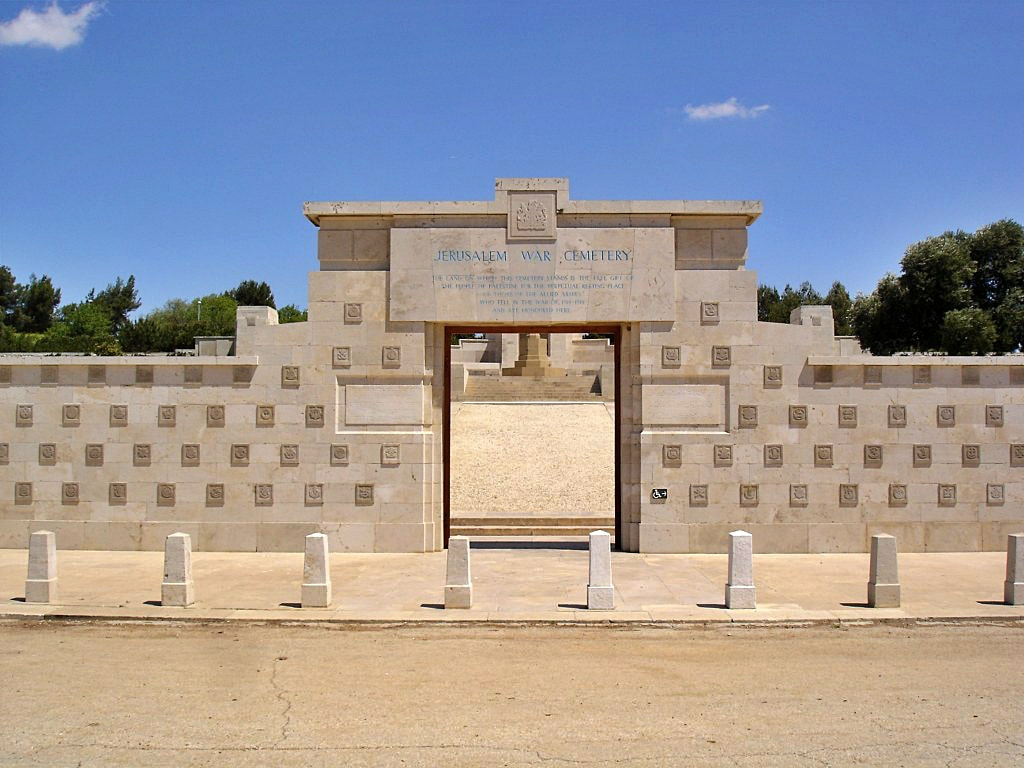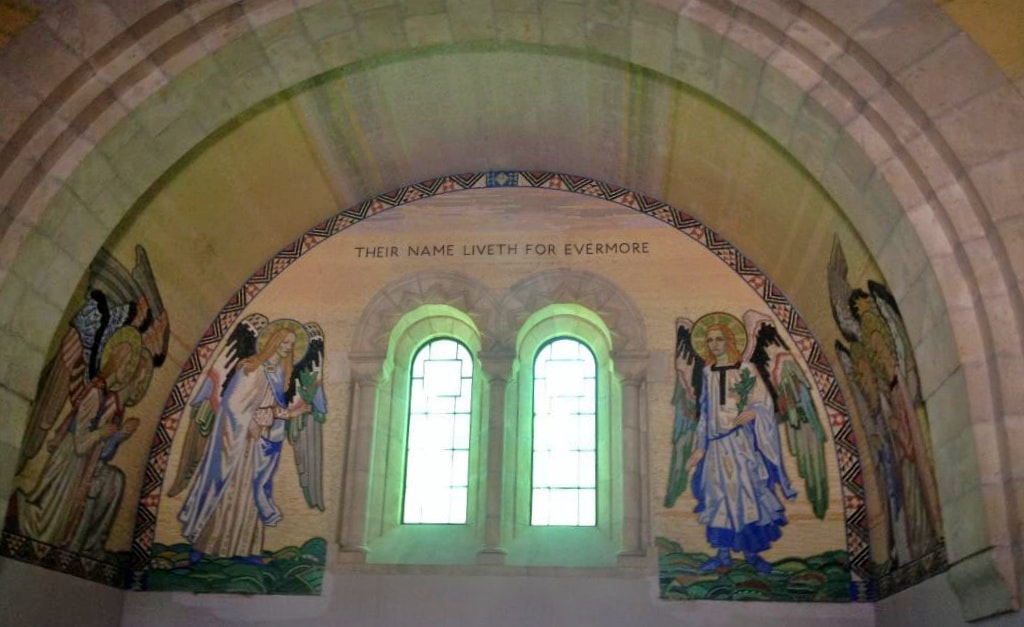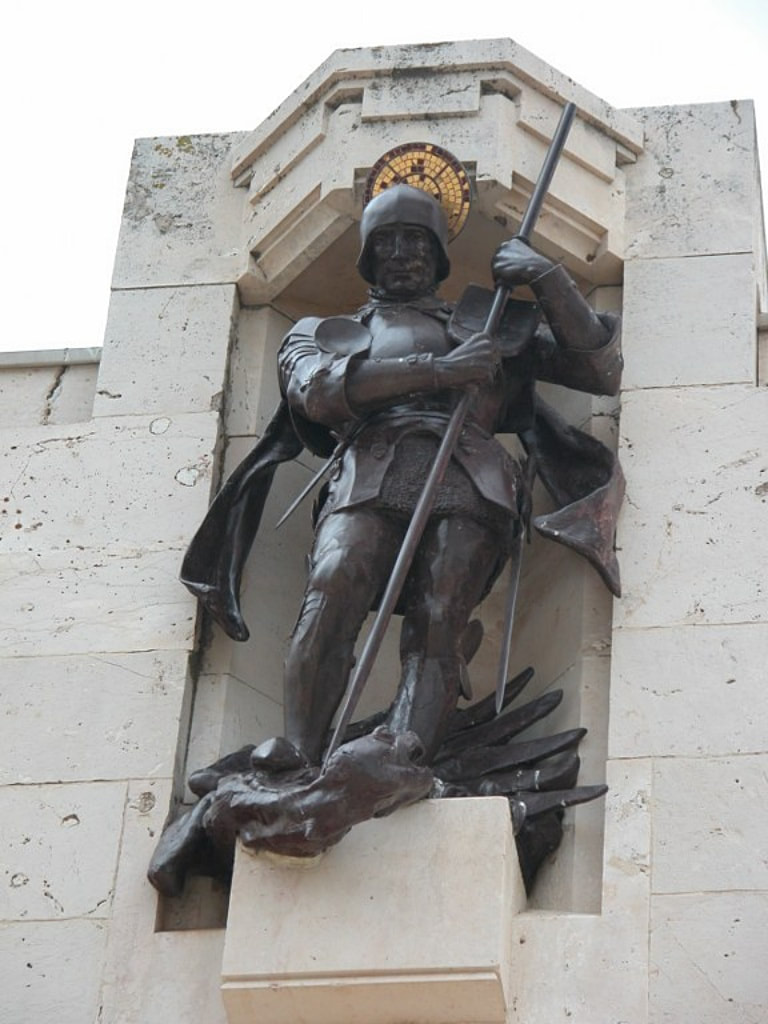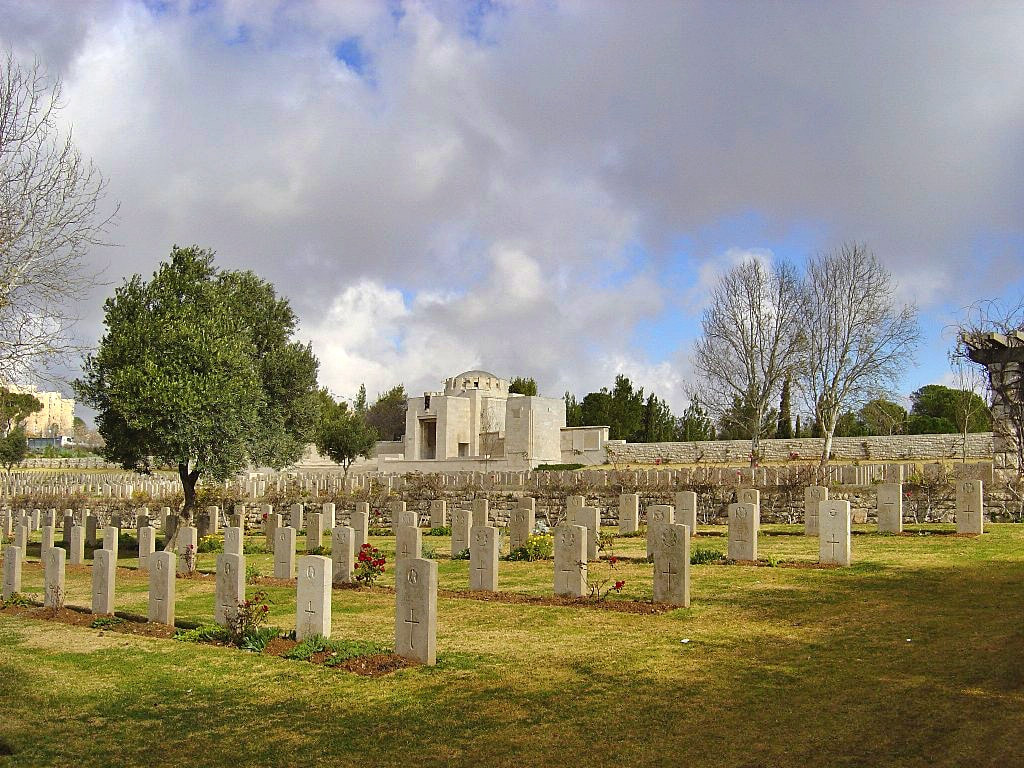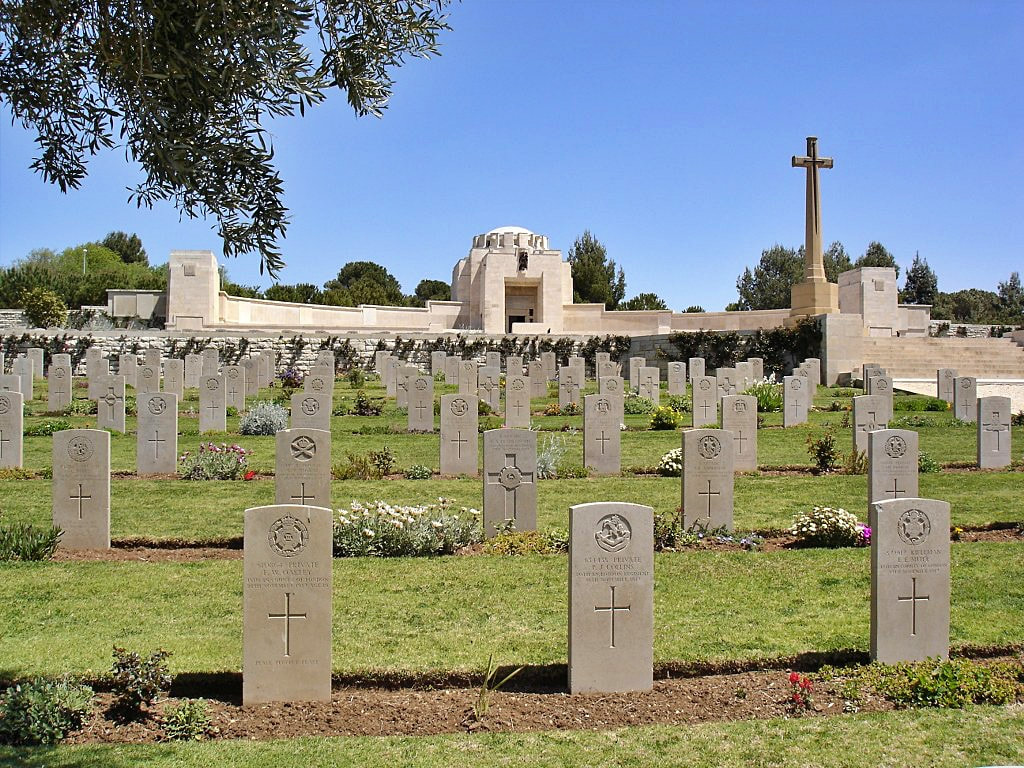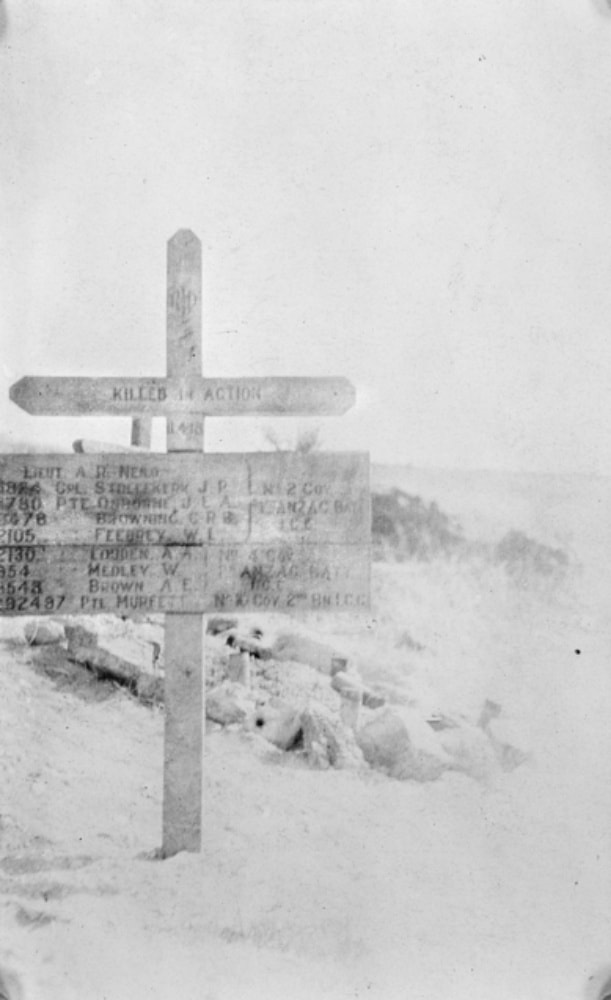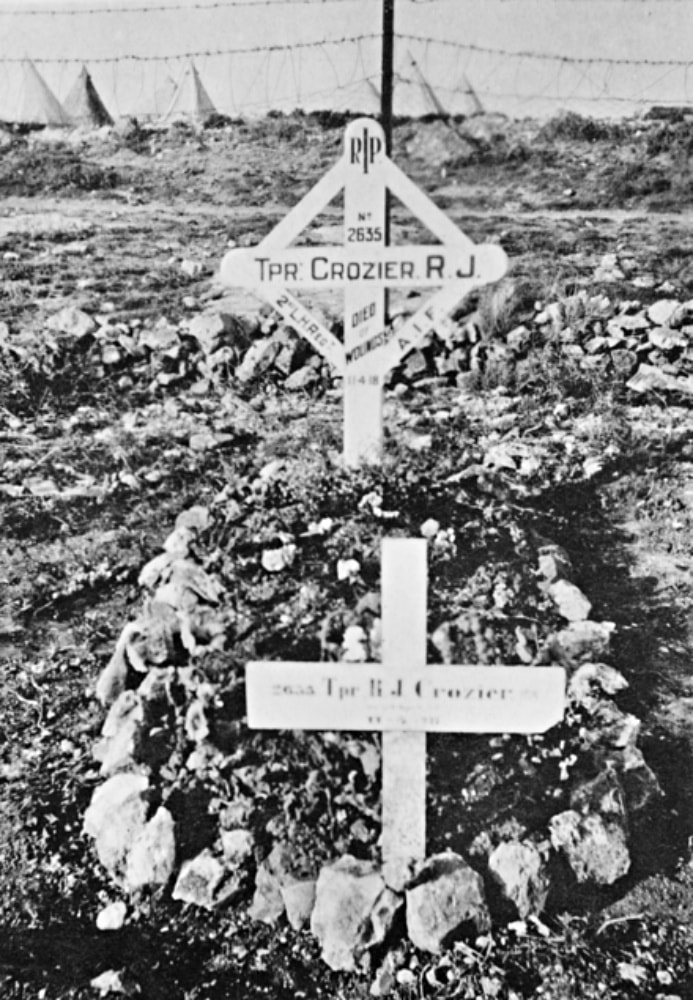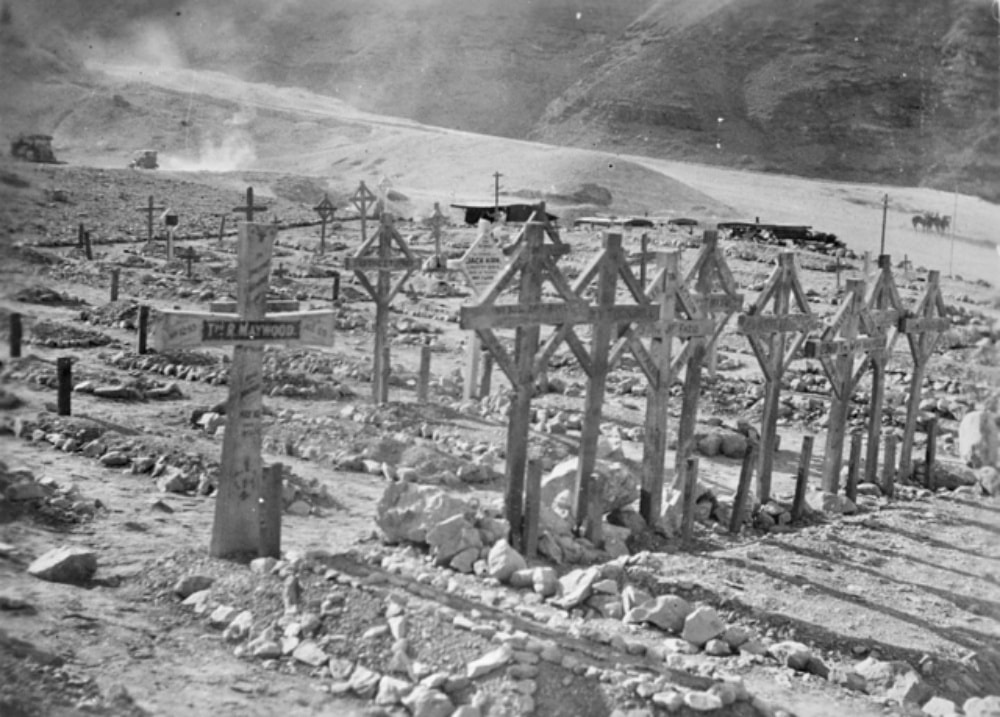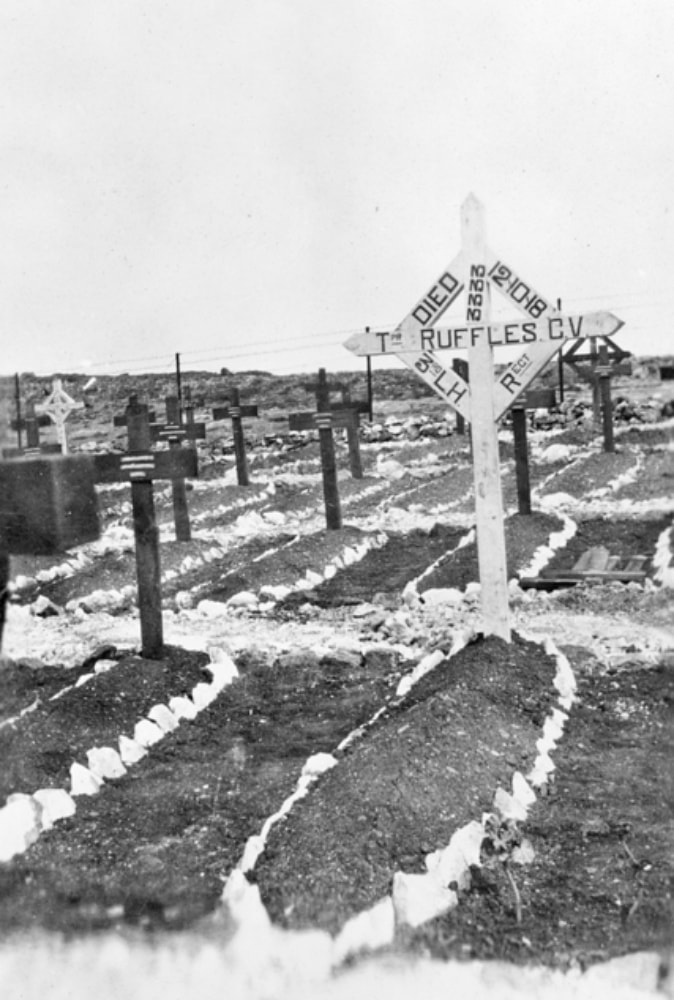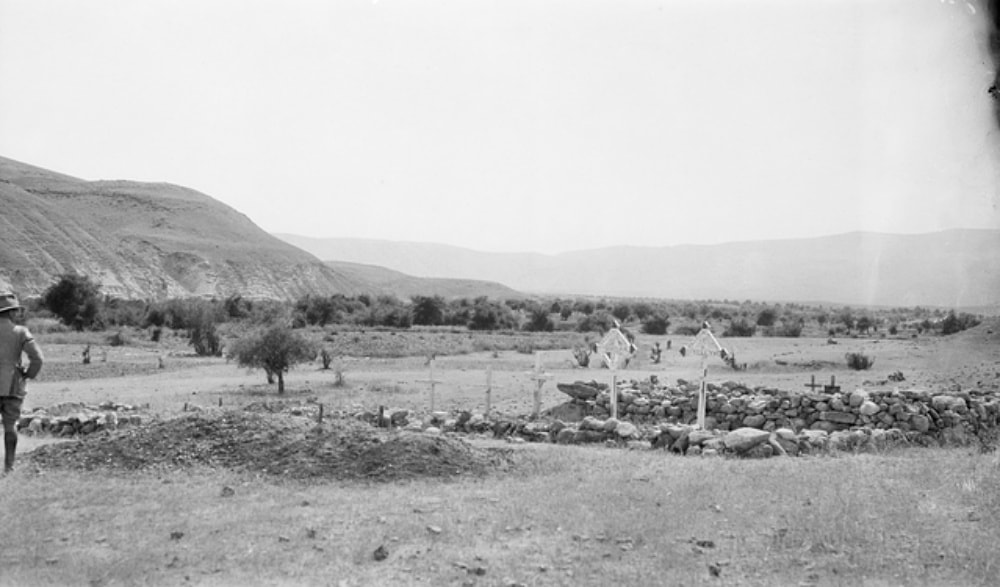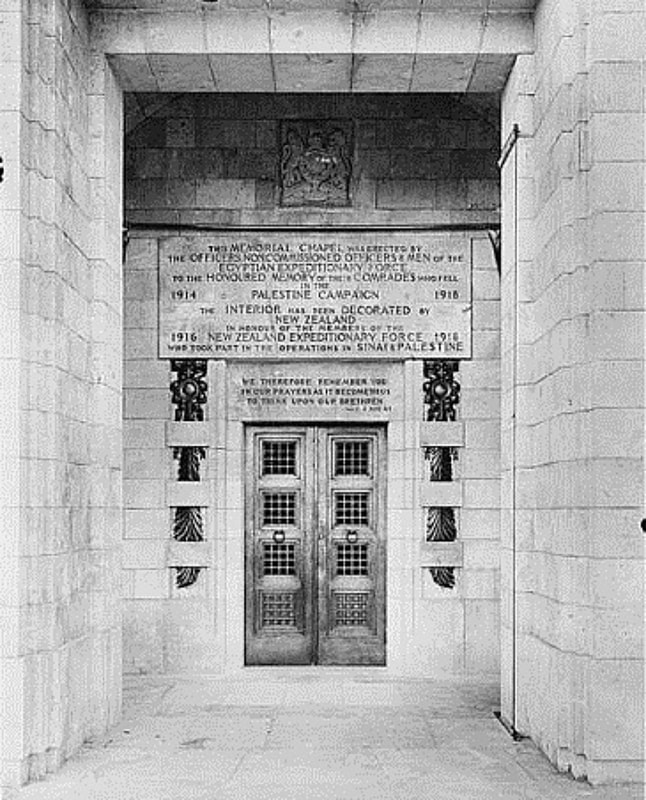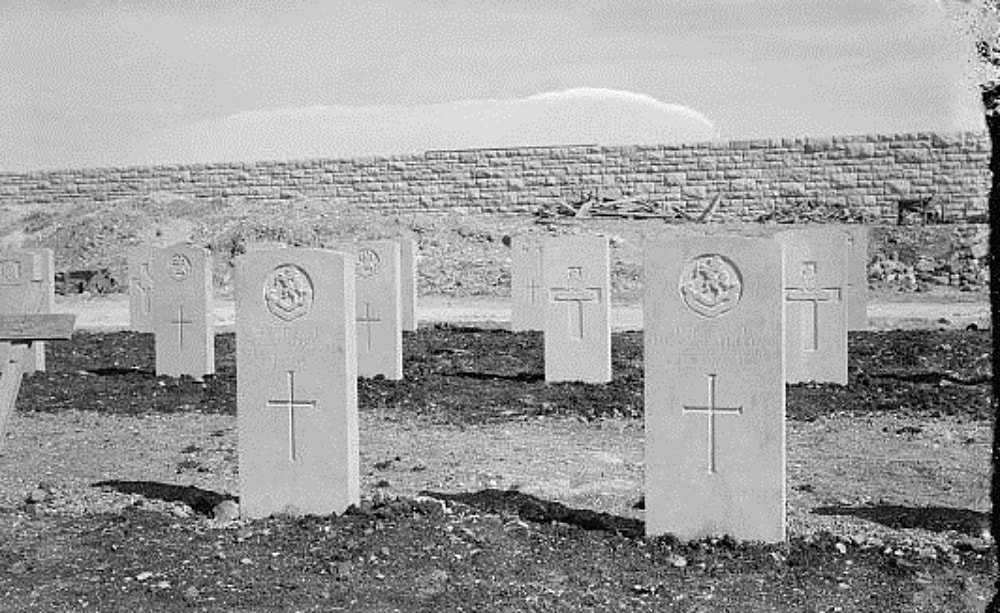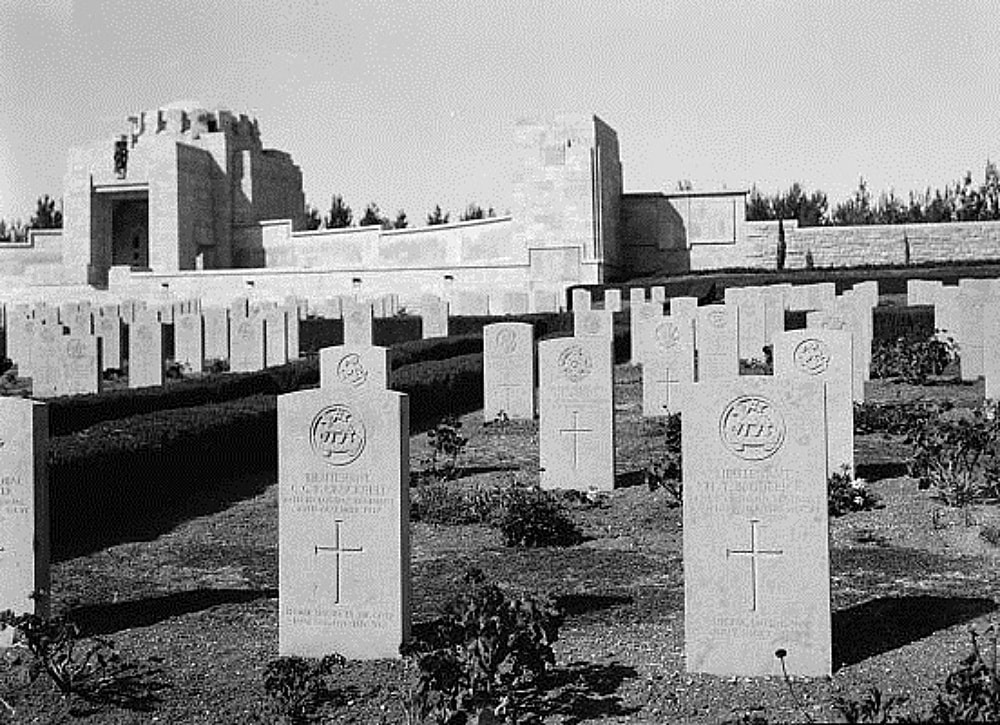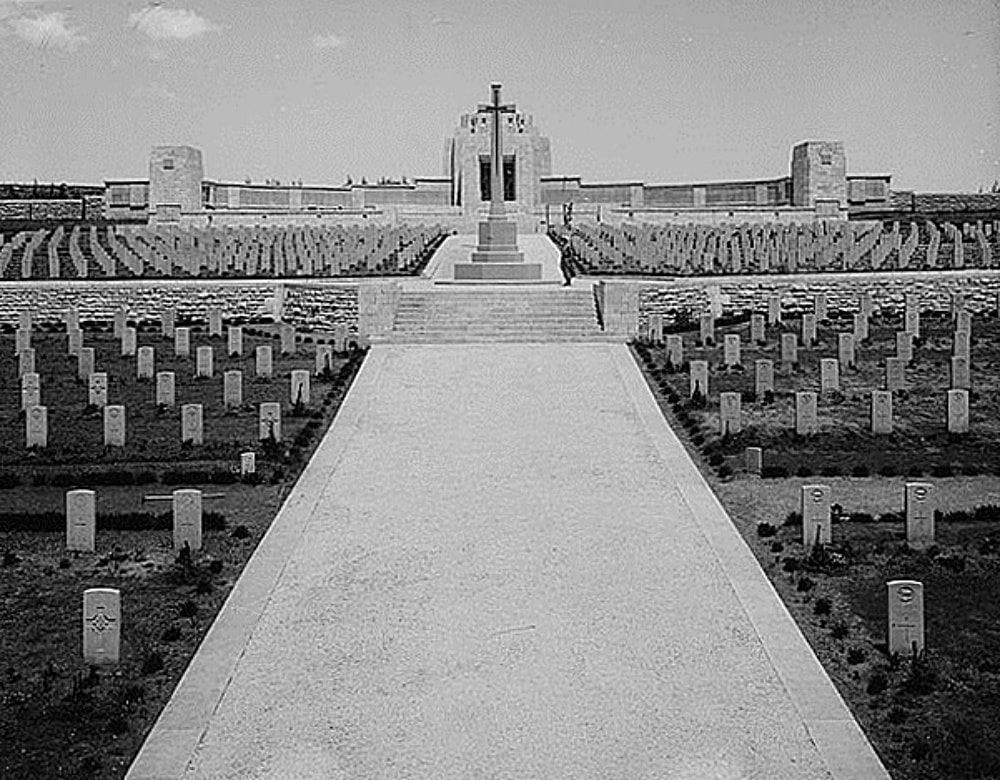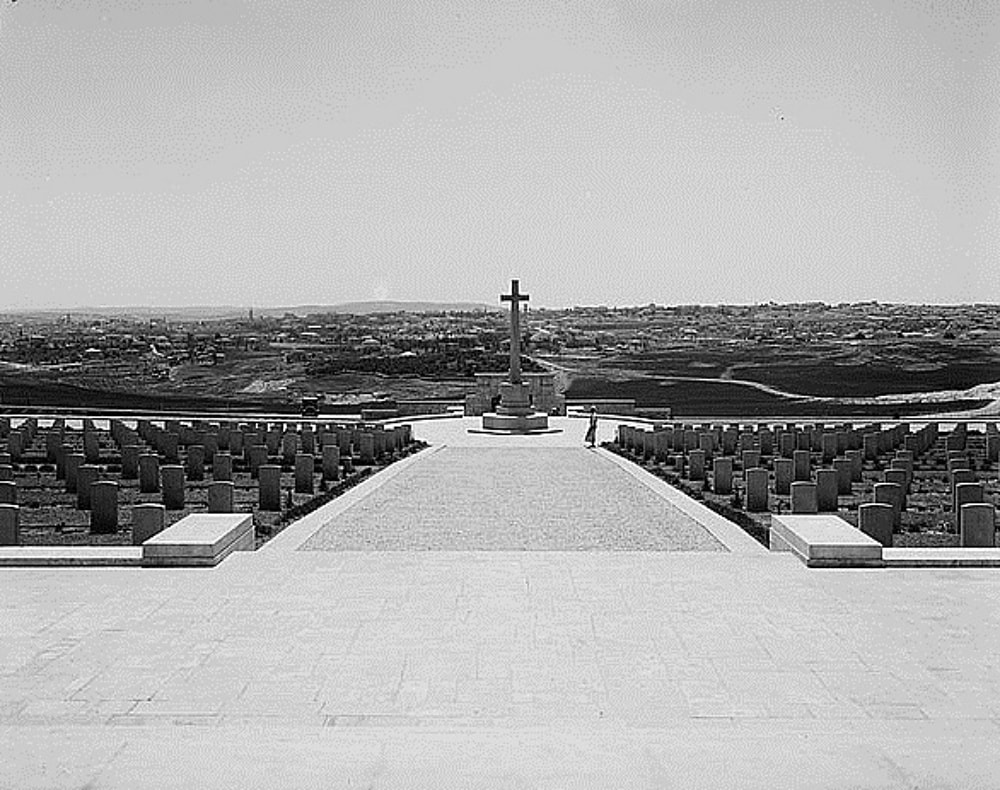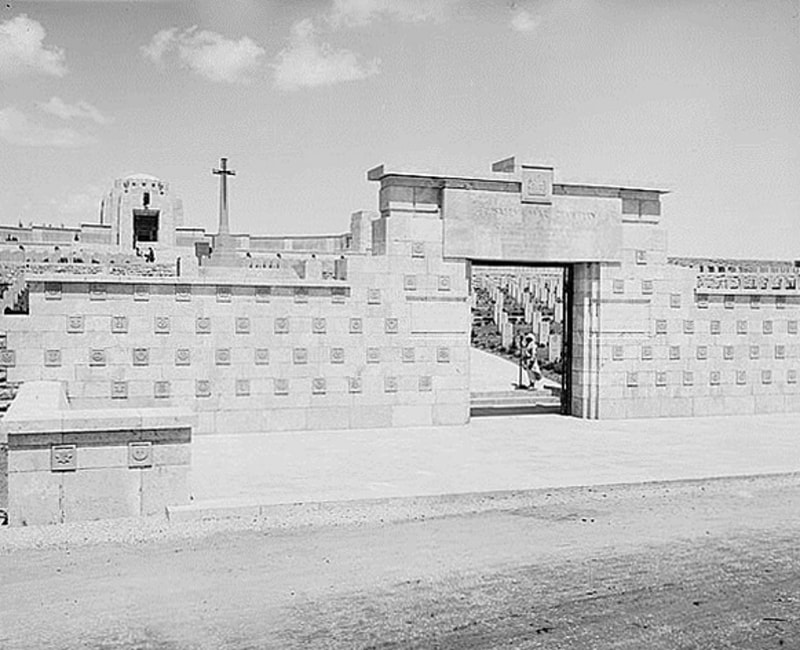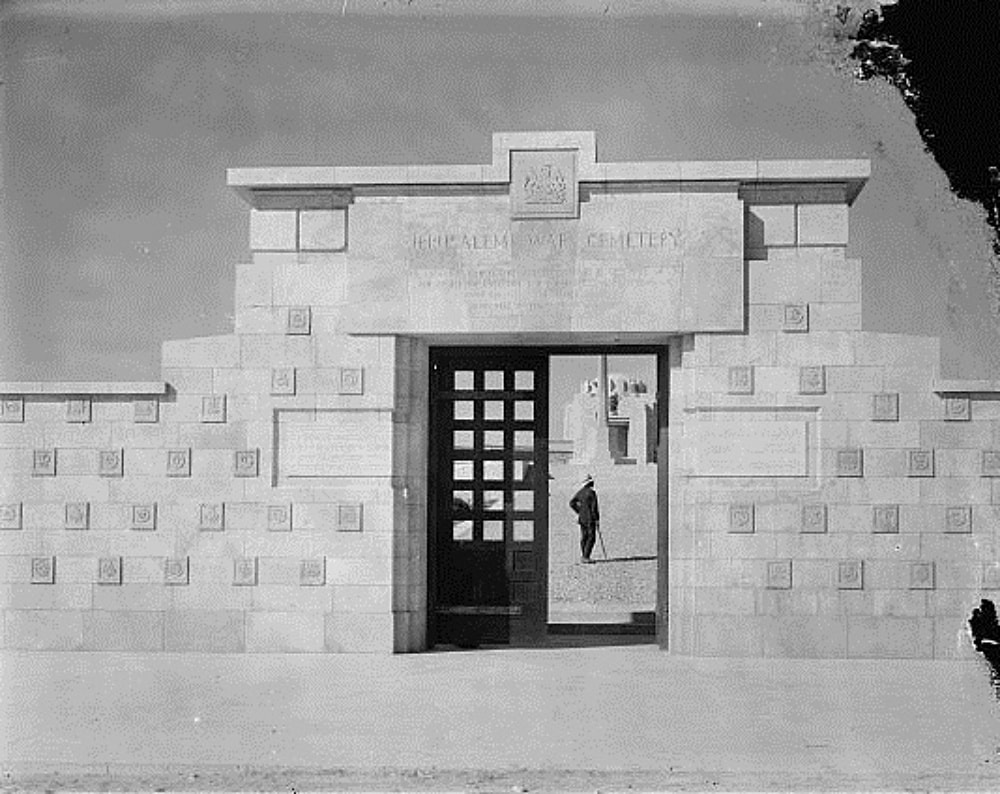JERUSALEM WAR CEMETERY
Jerusalem
Israel and Palestine (Including Gaza)
GPS Coordinates: Latitude: 31.79812, Longitude: 35.23947
Location Information
Jerusalem War Cemetery is 4.5 kilometres north of the walled city and is situated on the neck of land at the north end of the Mount of Olives, to the west of Mount Scopus. The cemetery is found on Churchill Blvd, next to the Hadassah Hospital. The Australian Memorial is opposite the cemetery entrance.
Visiting Information
The Cemetery is permanently open and may be visited at any time. Robert Anning Bell's mosaic, commissioned by the New Zealand Government to honour its forces that took part in the operations in Sinai and Palestine, can be seen in the Memorial Chapel. This is opened by appointment only, but unfortunately due to its design, it is not accessible to wheelchair users.
Wheelchair access to site possible via an alternative entrance. For further information and enquiries please contact [email protected]
Historical Information
At the outbreak of the First World War, Palestine (now Israel) was part of the Turkish Empire and it was not entered by Allied forces until December 1916. The advance to Jerusalem took a further year, but from 1914 to December 1917, about 250 Commonwealth prisoners of war were buried in the German and Anglo-German cemeteries of the city.
By 21 November 1917, the Egyptian Expeditionary Force had gained a line about five kilometres west of Jerusalem, but the city was deliberately spared bombardment and direct attack. Very severe fighting followed, lasting until the evening of 8 December, when the 53rd (Welsh) Division on the south, and the 60th (London) and 74th (Yeomanry) Divisions on the west, had captured all the city's prepared defences. Turkish forces left Jerusalem throughout that night and in the morning of 9 December, the Mayor came to the Allied lines with the Turkish Governor's letter of surrender. Jerusalem was occupied that day and on 11 December, General Allenby formally entered the city, followed by representatives of France and Italy.
Meanwhile, the 60th Division pushed across the road to Nablus, and the 53rd across the eastern road. From 26 to 30 December, severe fighting took place to the north and east of the city but it remained in Allied hands.
JERUSALEM WAR CEMETERY was begun after the occupation of the city, with 270 burials. It was later enlarged to take graves from the battlefields and smaller cemeteries in the neighbourhood, including:-
BETHLEHEM GERMAN CEMETERY, in which one man of the Australian Light Horse was buried in June 1918.
JERICHO MILITARY CEMETERY No.1, a little South of the Jerusalem road, which contained the graves of 61 soldiers from the United Kingdom, 27 from Australia and six from New Zealand. Jericho was entered by the 1st Australian Light Horse Brigade on the 21st February 1918, and in May the 2nd/4th London Field Ambulance was stationed there.
JERICHO MILITARY CEMETERY No.2, approximately 3 kilometres South West of the town. It contained the graves of 17 soldiers from Australia, 17 from India, nine from the United Kingdom, six from the West Indies and three from New Zealand; one man of the Egyptian Labour Corps; and four German and three Turkish prisoners.
JERUSALEM PROTESTANT CEMETERY, on the side of Mount Zion. It was owned by the British and German religious communities. It contained the graves of 114 British soldiers, buried from March to December 1917, by the enemy, and then, until February 1918, by the British forces.
JERUSALEM GERMAN HOSPICE MILITARY CEMETERY, on the Mount of Olives, in which 166 British and a number of German soldiers were buried.
LIMBER HILL MILITARY CEMETERY No.1, close to a Casualty Clearing Station, near the road from Bireh to Jufna. Here were buried, in April-October 1918, 70 soldiers from India, 31 from the United Kingdom, three of the Cape Corps and one German prisoner.
RAM ALLAH MILITARY CEMETERY, where 19 soldiers from the United Kingdom and one German airman were buried from December 1917 until April 1918.
There are now 2,515 Commonwealth burials of the First World War in the cemetery, 100 of them unidentified.
There is a small Jewish Section, near Plot "N".
Total Burials: 2,540.
World War One Identified Casualties: United Kingdom 2,184, Australia 144, South Africa 51, New Zealand 34, Germany 16, Italy 4, India 2. Total 2,435.
World War One Unidentified Casualties: United Kingdom 35, Unknown 65. Total 100.
Within the cemetery stands the JERUSALEM MEMORIAL, commemorating 3,312 Commonwealth servicemen who died during the First World War in operations in Egypt or Palestine and who have no known grave. It was designed by Sir John Burnet, with sculpture by Gilbert Bayes. In addition, the mosaic in the Memorial Chapel was designed by Robert Anning Bell. The Memorial was unveiled by Lord Allenby and Sir James Parr on 7 May 1927.
Jerusalem War Cemetery is 4.5 kilometres north of the walled city and is situated on the neck of land at the north end of the Mount of Olives, to the west of Mount Scopus. The cemetery is found on Churchill Blvd, next to the Hadassah Hospital. The Australian Memorial is opposite the cemetery entrance.
Visiting Information
The Cemetery is permanently open and may be visited at any time. Robert Anning Bell's mosaic, commissioned by the New Zealand Government to honour its forces that took part in the operations in Sinai and Palestine, can be seen in the Memorial Chapel. This is opened by appointment only, but unfortunately due to its design, it is not accessible to wheelchair users.
Wheelchair access to site possible via an alternative entrance. For further information and enquiries please contact [email protected]
Historical Information
At the outbreak of the First World War, Palestine (now Israel) was part of the Turkish Empire and it was not entered by Allied forces until December 1916. The advance to Jerusalem took a further year, but from 1914 to December 1917, about 250 Commonwealth prisoners of war were buried in the German and Anglo-German cemeteries of the city.
By 21 November 1917, the Egyptian Expeditionary Force had gained a line about five kilometres west of Jerusalem, but the city was deliberately spared bombardment and direct attack. Very severe fighting followed, lasting until the evening of 8 December, when the 53rd (Welsh) Division on the south, and the 60th (London) and 74th (Yeomanry) Divisions on the west, had captured all the city's prepared defences. Turkish forces left Jerusalem throughout that night and in the morning of 9 December, the Mayor came to the Allied lines with the Turkish Governor's letter of surrender. Jerusalem was occupied that day and on 11 December, General Allenby formally entered the city, followed by representatives of France and Italy.
Meanwhile, the 60th Division pushed across the road to Nablus, and the 53rd across the eastern road. From 26 to 30 December, severe fighting took place to the north and east of the city but it remained in Allied hands.
JERUSALEM WAR CEMETERY was begun after the occupation of the city, with 270 burials. It was later enlarged to take graves from the battlefields and smaller cemeteries in the neighbourhood, including:-
BETHLEHEM GERMAN CEMETERY, in which one man of the Australian Light Horse was buried in June 1918.
JERICHO MILITARY CEMETERY No.1, a little South of the Jerusalem road, which contained the graves of 61 soldiers from the United Kingdom, 27 from Australia and six from New Zealand. Jericho was entered by the 1st Australian Light Horse Brigade on the 21st February 1918, and in May the 2nd/4th London Field Ambulance was stationed there.
JERICHO MILITARY CEMETERY No.2, approximately 3 kilometres South West of the town. It contained the graves of 17 soldiers from Australia, 17 from India, nine from the United Kingdom, six from the West Indies and three from New Zealand; one man of the Egyptian Labour Corps; and four German and three Turkish prisoners.
JERUSALEM PROTESTANT CEMETERY, on the side of Mount Zion. It was owned by the British and German religious communities. It contained the graves of 114 British soldiers, buried from March to December 1917, by the enemy, and then, until February 1918, by the British forces.
JERUSALEM GERMAN HOSPICE MILITARY CEMETERY, on the Mount of Olives, in which 166 British and a number of German soldiers were buried.
LIMBER HILL MILITARY CEMETERY No.1, close to a Casualty Clearing Station, near the road from Bireh to Jufna. Here were buried, in April-October 1918, 70 soldiers from India, 31 from the United Kingdom, three of the Cape Corps and one German prisoner.
RAM ALLAH MILITARY CEMETERY, where 19 soldiers from the United Kingdom and one German airman were buried from December 1917 until April 1918.
There are now 2,515 Commonwealth burials of the First World War in the cemetery, 100 of them unidentified.
There is a small Jewish Section, near Plot "N".
Total Burials: 2,540.
World War One Identified Casualties: United Kingdom 2,184, Australia 144, South Africa 51, New Zealand 34, Germany 16, Italy 4, India 2. Total 2,435.
World War One Unidentified Casualties: United Kingdom 35, Unknown 65. Total 100.
Within the cemetery stands the JERUSALEM MEMORIAL, commemorating 3,312 Commonwealth servicemen who died during the First World War in operations in Egypt or Palestine and who have no known grave. It was designed by Sir John Burnet, with sculpture by Gilbert Bayes. In addition, the mosaic in the Memorial Chapel was designed by Robert Anning Bell. The Memorial was unveiled by Lord Allenby and Sir James Parr on 7 May 1927.
Images below used with the permission of the CWGC

2928 Trooper
Lindsay Lee Archibald
2nd Australian Light Horse
11th April 1918, aged 27.
Plot H. 9.
Son of John and Sarah Archibald. Native of Newtown, New South Wales.
Studio portrait of 2928 Private (Pte) Lindsay Lee Archibald, 2nd Light Horse Regiment (LHR) from Newtown, Sydney, NSW. A 25 year old railway station porter prior to enlisting on 16 March 1916, he embarked for overseas service with the 21st Reinforcements from Sydney aboard RMS Mooltan on 19 August 1916. After disembarking in Egypt, he spent a month with the 1st Light Horse Training Regiment before joining the 2nd LHR for service in the Middle East. Pte Archibald was killed in action on 11 April 1918 and buried near where he fell at El Ghoraniye in the Jordan Valley near Jericho. After the war, his remains were moved to the Jerusalem War Cemetery.
Lindsay Lee Archibald
2nd Australian Light Horse
11th April 1918, aged 27.
Plot H. 9.
Son of John and Sarah Archibald. Native of Newtown, New South Wales.
Studio portrait of 2928 Private (Pte) Lindsay Lee Archibald, 2nd Light Horse Regiment (LHR) from Newtown, Sydney, NSW. A 25 year old railway station porter prior to enlisting on 16 March 1916, he embarked for overseas service with the 21st Reinforcements from Sydney aboard RMS Mooltan on 19 August 1916. After disembarking in Egypt, he spent a month with the 1st Light Horse Training Regiment before joining the 2nd LHR for service in the Middle East. Pte Archibald was killed in action on 11 April 1918 and buried near where he fell at El Ghoraniye in the Jordan Valley near Jericho. After the war, his remains were moved to the Jerusalem War Cemetery.
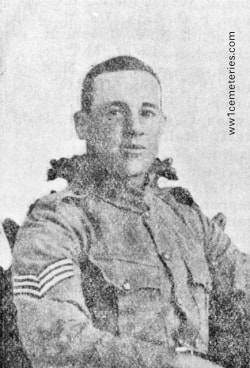
530 Sergeant
Wilfrid Mapon Chaille
5th Australian Light Horse
14th July 1918, aged 26.
Plot J. 28.
Son of James Mapon Chaille and Charlotte Ann Chaille, of Esk, Queensland.
His headstone bears the inscription "A Happy, Cheerful Soul Was Our Boy Pat Beloved By All Who Knew Him"
Studio portrait of 538 Sergeant (Sgt) Wilfrid Mapon Chaille, 5th Light Horse Regiment, of Esk, Qld. Sgt Chaille enlisted on 7 November 1914 and embarked from Sydney on HMAT Persic on 21 December 1914. He was killed in action on 14 July 1918, in the Jordan Valley, Palestine, aged 26.
Wilfrid Mapon Chaille
5th Australian Light Horse
14th July 1918, aged 26.
Plot J. 28.
Son of James Mapon Chaille and Charlotte Ann Chaille, of Esk, Queensland.
His headstone bears the inscription "A Happy, Cheerful Soul Was Our Boy Pat Beloved By All Who Knew Him"
Studio portrait of 538 Sergeant (Sgt) Wilfrid Mapon Chaille, 5th Light Horse Regiment, of Esk, Qld. Sgt Chaille enlisted on 7 November 1914 and embarked from Sydney on HMAT Persic on 21 December 1914. He was killed in action on 14 July 1918, in the Jordan Valley, Palestine, aged 26.
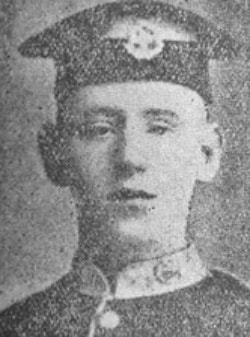
57217 Private
Joseph Emmett
Royal Army Medical Corps
Died of Wounds 29th November 1917, aged 34.
Plot C. 50.
Son of James and Margaret Emmett; husband of Martha Ann Emmett, of 15, Pheasantford St., Burnley.
Joseph Emmett
Royal Army Medical Corps
Died of Wounds 29th November 1917, aged 34.
Plot C. 50.
Son of James and Margaret Emmett; husband of Martha Ann Emmett, of 15, Pheasantford St., Burnley.
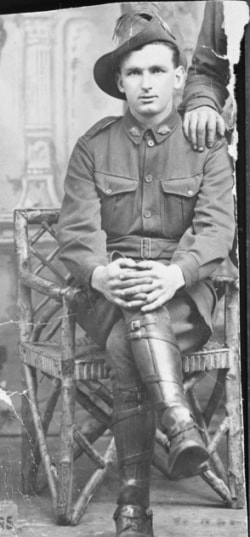
28 Trooper
Michael Thomas Farrell
8th Australian Light Horse
5th June 1918, aged 26.
Plot V. 23.
Son of Michael James and Bridget M. Farrell, of 31, Delbridge St. North Fitzroy, Victoria, Australia. Native of Garvoc, Victoria.
His headstone bears the inscription "Fond Memory Only A Grave; Have A Care Our Dear Son Lies Buried There"
Portrait of 28 Private Michael Thomas Farrell, of Garvoc, Victoria, 8th Australian Light Horse. Pte Farrell enlisted on 14 September 1914 and embarked from Melbourne aboard HMAT Star of Victoria on 25 February 1915. He died of wounds on 5 June 1918 in Palestine, aged 26 years. Pte Farrell’s brother, 2612 Pte (later Corporal (Cpl)) John Herbert Farrell, of Garvoc, Victoria, 6th Battalion was awarded the Military Medal (MM) on 2 May 1918, Bar to MM on 12 February 1919 and Distinguish Conduct Medal (DCM) on 3 June 1919.
Michael Thomas Farrell
8th Australian Light Horse
5th June 1918, aged 26.
Plot V. 23.
Son of Michael James and Bridget M. Farrell, of 31, Delbridge St. North Fitzroy, Victoria, Australia. Native of Garvoc, Victoria.
His headstone bears the inscription "Fond Memory Only A Grave; Have A Care Our Dear Son Lies Buried There"
Portrait of 28 Private Michael Thomas Farrell, of Garvoc, Victoria, 8th Australian Light Horse. Pte Farrell enlisted on 14 September 1914 and embarked from Melbourne aboard HMAT Star of Victoria on 25 February 1915. He died of wounds on 5 June 1918 in Palestine, aged 26 years. Pte Farrell’s brother, 2612 Pte (later Corporal (Cpl)) John Herbert Farrell, of Garvoc, Victoria, 6th Battalion was awarded the Military Medal (MM) on 2 May 1918, Bar to MM on 12 February 1919 and Distinguish Conduct Medal (DCM) on 3 June 1919.
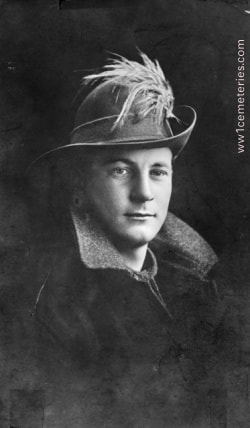
3933 Trooper
Malvern Plymton Folland
1st Australian Bn. Imperial Camel Corps (Australian)
11th April 1918, aged 21.
Plot H. 56.
Son of Clement Williams Folland and Agnes Emma Folland, of Williams, Western Australia. Native of Plympton, Western Australia.
His headstone bears the inscription "A Higher Service to Him Is Given"
Studio portrait of 3933 Trooper (Tpr) Malvern Plymton Folland, 1st Anzac Battalion Imperial Camel Corps, of Plympton (East Fremantle), Western Australia. A labourer prior to enlistment on 1 August 1917, Tpr Folland served for 6 weeks in Western Australia with the 10th Light Horse. He was then transferred to the 15th Camel Corps reinforcements on the day of his embarkation from Fremantle aboard HMAT Commonwealth on 9 November 1917. He was killed in action in Palestine on 11 April 1918, aged 21. His brother 4035 Pte Vivian Iceley Folland served with the 48th and 51st Battalions on the Western Front and returned to Australia in 1919.
Malvern Plymton Folland
1st Australian Bn. Imperial Camel Corps (Australian)
11th April 1918, aged 21.
Plot H. 56.
Son of Clement Williams Folland and Agnes Emma Folland, of Williams, Western Australia. Native of Plympton, Western Australia.
His headstone bears the inscription "A Higher Service to Him Is Given"
Studio portrait of 3933 Trooper (Tpr) Malvern Plymton Folland, 1st Anzac Battalion Imperial Camel Corps, of Plympton (East Fremantle), Western Australia. A labourer prior to enlistment on 1 August 1917, Tpr Folland served for 6 weeks in Western Australia with the 10th Light Horse. He was then transferred to the 15th Camel Corps reinforcements on the day of his embarkation from Fremantle aboard HMAT Commonwealth on 9 November 1917. He was killed in action in Palestine on 11 April 1918, aged 21. His brother 4035 Pte Vivian Iceley Folland served with the 48th and 51st Battalions on the Western Front and returned to Australia in 1919.
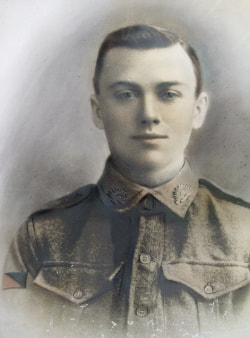
1573 Sergeant
Charles Franklyn Fuhrmann
10th Australian Light Horse
13th August 1918, aged 29.
Plot W. 66.
Son of William Charles and Frederica Fuhrmann, of Drouin, Victoria, Australia.
His headstone bears the inscription "In Memory Of The Dearly Loved Son Of Mr. & Mrs. Fuhrmann Of Drouin"
Studio portrait of 1573 Private (Pte) Charles Franklyn Fuhrmann, 10th Light Horse Regiment, of Subiaco, WA. An accountant prior to enlisting in September 1915, Pte Fuhrmann embarked from Fremantle on board RMS Mongolia on 22 November 1915. He served in Egypt and Palestine and was promoted to Corporal in December 1916. In July 1917 he was promoted to Sergeant (Sgt) and was later attached to the School of Instruction in Egypt. On 2 August 1918 Sgt Fuhrmann was hospitalised in Jerusalem with pneumonia. He died on 13 August 1918, aged 29. Sgt Fuhrmann's brother 2996 Pte Guido Nelson Fuhrmann served with the 8th Light Horse Regiment and returned to Australia in July 1919.
Charles Franklyn Fuhrmann
10th Australian Light Horse
13th August 1918, aged 29.
Plot W. 66.
Son of William Charles and Frederica Fuhrmann, of Drouin, Victoria, Australia.
His headstone bears the inscription "In Memory Of The Dearly Loved Son Of Mr. & Mrs. Fuhrmann Of Drouin"
Studio portrait of 1573 Private (Pte) Charles Franklyn Fuhrmann, 10th Light Horse Regiment, of Subiaco, WA. An accountant prior to enlisting in September 1915, Pte Fuhrmann embarked from Fremantle on board RMS Mongolia on 22 November 1915. He served in Egypt and Palestine and was promoted to Corporal in December 1916. In July 1917 he was promoted to Sergeant (Sgt) and was later attached to the School of Instruction in Egypt. On 2 August 1918 Sgt Fuhrmann was hospitalised in Jerusalem with pneumonia. He died on 13 August 1918, aged 29. Sgt Fuhrmann's brother 2996 Pte Guido Nelson Fuhrmann served with the 8th Light Horse Regiment and returned to Australia in July 1919.

2289 Trooper
Claude Henry Jackson
8th Australian Light Horse
Killed in action on 11th April 1918, aged 30.
Plot H. 55.
Son of Henry and Henrietta Jackson, of Union St., Kilmore, Victoria, Australia.
His headstone bears the inscription "Safe In His Heavenly Home Above He Fought For Those Who Loved Him"
Click on image to enlarge
Claude Henry Jackson
8th Australian Light Horse
Killed in action on 11th April 1918, aged 30.
Plot H. 55.
Son of Henry and Henrietta Jackson, of Union St., Kilmore, Victoria, Australia.
His headstone bears the inscription "Safe In His Heavenly Home Above He Fought For Those Who Loved Him"
Click on image to enlarge
Original Grave Markers
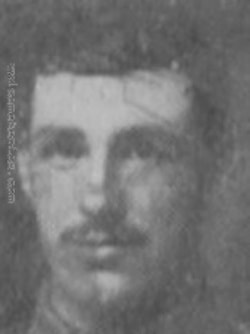
43552 Private
William George Kite
1st (Garr.) Bn. Devonshire Regiment
24th November 1918, aged 31.
Plot Q. 138.
Husband of Mabel Kite, of 5, Mill Lane, West Twerton, Bath.
His headstone bears the inscription "Too Far Away Thy Grave To See But Not Too Far To Think Of Thee"
William George Kite
1st (Garr.) Bn. Devonshire Regiment
24th November 1918, aged 31.
Plot Q. 138.
Husband of Mabel Kite, of 5, Mill Lane, West Twerton, Bath.
His headstone bears the inscription "Too Far Away Thy Grave To See But Not Too Far To Think Of Thee"
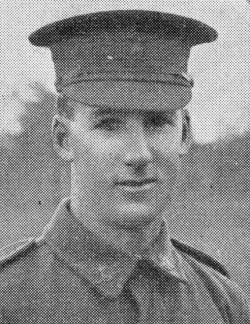
1413 Shoeing Smith
William James Hamilton Lowe
2nd Australian Light Horse Machine Gun Squadron
28th August 1918.
Plot J. 31.
Son of Hamilton Walter and Eliza Jane Lowe, of Crudine, Ilford, New South Wales.
His headstone bears the inscription "He Died For Australia And Those He Loved"
Studio portrait of 1413 Driver (later Shoeing Smith) William James Hamilton Lowe, 12th Light Horse Regiment (later 2nd Australian Light Horse Machine Gun Squadron) of Grudine via Mudgee, NSW. A farmer prior to enlisting, he embarked from Sydney aboard HMAT Uganda (A66) on 20 November 1915. He was killed in action on 28 August 1918, near Jericho, Palestine, aged 24.
William James Hamilton Lowe
2nd Australian Light Horse Machine Gun Squadron
28th August 1918.
Plot J. 31.
Son of Hamilton Walter and Eliza Jane Lowe, of Crudine, Ilford, New South Wales.
His headstone bears the inscription "He Died For Australia And Those He Loved"
Studio portrait of 1413 Driver (later Shoeing Smith) William James Hamilton Lowe, 12th Light Horse Regiment (later 2nd Australian Light Horse Machine Gun Squadron) of Grudine via Mudgee, NSW. A farmer prior to enlisting, he embarked from Sydney aboard HMAT Uganda (A66) on 20 November 1915. He was killed in action on 28 August 1918, near Jericho, Palestine, aged 24.

356 Corporal
Sydney George Masters
2nd Australian Light Horse
14th July 1918, aged 28.
Plot H. 80.
Son of George and Rhoda Masters, of Allora, Queensland.
Studio portrait of 356 Corporal (Cpl) Sidney George Masters, B Squadron, 2nd Light Horse Regiment, of Allora, Qld. Prior to enlistment on 21 August 1914, Cpl Masters served with the 3rd (Darling Downs) Light Horse Regiment, Citizens Military Forces. He embarked from Brisbane aboard HMAT Star of England on 24 September 1914 and served at the Gallipoli Peninsula before being invalided home suffering from trench fever. After two months recuperation he returned to duty and embarked from Sydney aboard HMAT Karroo with the 17th Reinforcements, 2nd Light Horse, on 5 May 1916. Cpl Masters was killed in action on 14 July 1918 at 'The Bluff' Abu Tellul, Palestine.
Sydney George Masters
2nd Australian Light Horse
14th July 1918, aged 28.
Plot H. 80.
Son of George and Rhoda Masters, of Allora, Queensland.
Studio portrait of 356 Corporal (Cpl) Sidney George Masters, B Squadron, 2nd Light Horse Regiment, of Allora, Qld. Prior to enlistment on 21 August 1914, Cpl Masters served with the 3rd (Darling Downs) Light Horse Regiment, Citizens Military Forces. He embarked from Brisbane aboard HMAT Star of England on 24 September 1914 and served at the Gallipoli Peninsula before being invalided home suffering from trench fever. After two months recuperation he returned to duty and embarked from Sydney aboard HMAT Karroo with the 17th Reinforcements, 2nd Light Horse, on 5 May 1916. Cpl Masters was killed in action on 14 July 1918 at 'The Bluff' Abu Tellul, Palestine.

1030 Corporal
Arnold Selwyn Metcalfe
1st Australian Light Horse
19th April 1918, aged 23.
Plot H. 11.
Son of Charles Joseph and Laura Annie Metcalfe, of Young, New South Wales.
His headstone bears the inscription "A Beloved Son And Affectionate Brother"
Studio portrait of 1030 Corporal (Cpl) Arnold Selwyn Metcalfe, 1st Australian Light Horse Regiment, of Young, NSW. A bank clerk prior to enlistment, Cpl Metcalfe embarked for overseas service aboard HMAT Clan McEwen (A65) on 28 June 1915. Cpl Metcalfe served in Gallipoli, Egypt and Palestine before being killed in action on 19 April 1918, aged 23 years.
Arnold Selwyn Metcalfe
1st Australian Light Horse
19th April 1918, aged 23.
Plot H. 11.
Son of Charles Joseph and Laura Annie Metcalfe, of Young, New South Wales.
His headstone bears the inscription "A Beloved Son And Affectionate Brother"
Studio portrait of 1030 Corporal (Cpl) Arnold Selwyn Metcalfe, 1st Australian Light Horse Regiment, of Young, NSW. A bank clerk prior to enlistment, Cpl Metcalfe embarked for overseas service aboard HMAT Clan McEwen (A65) on 28 June 1915. Cpl Metcalfe served in Gallipoli, Egypt and Palestine before being killed in action on 19 April 1918, aged 23 years.
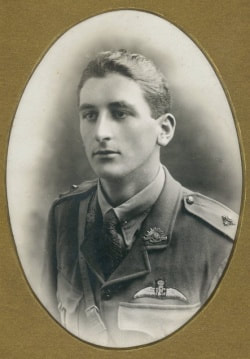
Lieutenant
Jack Diamond Sumner Potts
67th Squadron, Australian Flying Corps
4th January 1918, aged 21.
Plot X 34.
Son of Arthur Ernest and Luaetia Nannette Potts, of "Arcadia," Longueville, Sydney, New South Wales. Native of England.
His headstone bears the inscription "Procul Ning Ante Diem Periit Sed Miles Sed Pro Patria"
Studio portrait of 2nd Lieutenant Jack Diamond Sumner Potts, No 67 Squadron, AFC, probably taken in Egypt. A jackeroo from Longueville, NSW, prior to enlistment, 1203 Private (Pte) Jack Sumner Potts embarked with his brother 1181 Pte Leonard Malcolm Sumner Potts, from Sydney with the 8th Reinforcements, 7th Light Horse Regiment on HMAT Suffolk on 28 July 1915. The brothers transferred to the Australian Flying Corps. After qualifying as a pilot Jack Sumner Potts was promoted to Lieutenant (Lt) and posted to No. 67 (Australian) Squadron, RFC (previously No. 1 Squadron, AFC). Lt Sumner Potts died when on 4 January 1918 when his RE8 aircraft B5854 collided with another RE8 of No. 113 Squadron RFC. Lt Sumner Potts, Captain Harald Hewett, RFC, and 2nd Lieutenant A Butt, RFC, were buried with full military honours by German airmen. 2nd Lt Vincent John Parkinson, AFC, was the wireless operator and observer who survived the crash with a fractured skull and was taken prisoner of war (POW). The proceedings of a court on inquiry found that; 'On January 4th 1918, Lieut J D S Potts, Pilot and 2/Lieut V J Parkinson, Observer, were flying an R E S, on a bomb raid on the enemy aerodrome at Jenin. They failed to return...On January 10th, a message was dropped by Hostile aircraft which stated that our machine had been forced to land and that Lieut Potts had been buried and that 2/Lieut V J Parkinson was slightly wounded and was the a Prisoner of War. It also stated that Lieut Potts had been buried at Jenin, and enclosed a photograph of his grave.' Following the Armistice, Lt Sumner Potts remains were re-interred in the Jerusalem War Cemetery, Israel.
Jack Diamond Sumner Potts
67th Squadron, Australian Flying Corps
4th January 1918, aged 21.
Plot X 34.
Son of Arthur Ernest and Luaetia Nannette Potts, of "Arcadia," Longueville, Sydney, New South Wales. Native of England.
His headstone bears the inscription "Procul Ning Ante Diem Periit Sed Miles Sed Pro Patria"
Studio portrait of 2nd Lieutenant Jack Diamond Sumner Potts, No 67 Squadron, AFC, probably taken in Egypt. A jackeroo from Longueville, NSW, prior to enlistment, 1203 Private (Pte) Jack Sumner Potts embarked with his brother 1181 Pte Leonard Malcolm Sumner Potts, from Sydney with the 8th Reinforcements, 7th Light Horse Regiment on HMAT Suffolk on 28 July 1915. The brothers transferred to the Australian Flying Corps. After qualifying as a pilot Jack Sumner Potts was promoted to Lieutenant (Lt) and posted to No. 67 (Australian) Squadron, RFC (previously No. 1 Squadron, AFC). Lt Sumner Potts died when on 4 January 1918 when his RE8 aircraft B5854 collided with another RE8 of No. 113 Squadron RFC. Lt Sumner Potts, Captain Harald Hewett, RFC, and 2nd Lieutenant A Butt, RFC, were buried with full military honours by German airmen. 2nd Lt Vincent John Parkinson, AFC, was the wireless operator and observer who survived the crash with a fractured skull and was taken prisoner of war (POW). The proceedings of a court on inquiry found that; 'On January 4th 1918, Lieut J D S Potts, Pilot and 2/Lieut V J Parkinson, Observer, were flying an R E S, on a bomb raid on the enemy aerodrome at Jenin. They failed to return...On January 10th, a message was dropped by Hostile aircraft which stated that our machine had been forced to land and that Lieut Potts had been buried and that 2/Lieut V J Parkinson was slightly wounded and was the a Prisoner of War. It also stated that Lieut Potts had been buried at Jenin, and enclosed a photograph of his grave.' Following the Armistice, Lt Sumner Potts remains were re-interred in the Jerusalem War Cemetery, Israel.
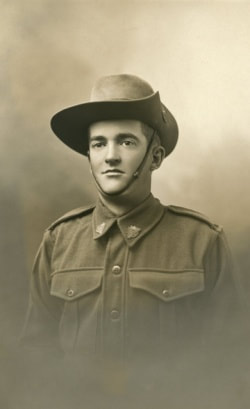
2957 Trooper
Bertie George Rixon
1st Australian Light Horse Machine Gun Squadron
14th July 1918, aged 24.
Plot J. 16.
Son of Benjamin and Eliza Ann Rixon, of Eden Creek, Kyogle, New South Wales. Native of Gullen, Crookwell, New South Wales.
His headstone bears the inscription "Loved And Remembered By All"
Studio portrait of 2957 Trooper (Tpr) Bertie George (Bert) Rixon, 2nd Light Horse Regiment, of Kyogle, NSW. A dairy farmer prior to enlistment, Tpr Rixon embarked with the 21st Reinforcements from Sydney on RMS Mooltan on 19 August 1916. On 14 July 1918 he was killed in action in the Jordan Valley, Palestine, aged 24 years.
Bertie George Rixon
1st Australian Light Horse Machine Gun Squadron
14th July 1918, aged 24.
Plot J. 16.
Son of Benjamin and Eliza Ann Rixon, of Eden Creek, Kyogle, New South Wales. Native of Gullen, Crookwell, New South Wales.
His headstone bears the inscription "Loved And Remembered By All"
Studio portrait of 2957 Trooper (Tpr) Bertie George (Bert) Rixon, 2nd Light Horse Regiment, of Kyogle, NSW. A dairy farmer prior to enlistment, Tpr Rixon embarked with the 21st Reinforcements from Sydney on RMS Mooltan on 19 August 1916. On 14 July 1918 he was killed in action in the Jordan Valley, Palestine, aged 24 years.

3051 Trooper
Victor Francis Rule
3rd Australian Light Horse
13th October 1918, aged 21.
Plot W. 30.
Son of George Archibald and Florence Rule, of Victor Mansions, Glenelg, South Australia.
His headstone bears the inscription "Greater Love Hath No Man He Laid Down His Life For His Friends"
Studio portrait of Private (Pte) Victor Francis Rule, 3rd Light Horse Regiment, of Plympton, SA. A bricklayer prior to enlistment, he embarked with the 23rd Reinforcements on board HMAT Bulla (A45) on 16 January 1917. Pte Rule died of malaria on 13 October 1918; he was 21 years of age.
Victor Francis Rule
3rd Australian Light Horse
13th October 1918, aged 21.
Plot W. 30.
Son of George Archibald and Florence Rule, of Victor Mansions, Glenelg, South Australia.
His headstone bears the inscription "Greater Love Hath No Man He Laid Down His Life For His Friends"
Studio portrait of Private (Pte) Victor Francis Rule, 3rd Light Horse Regiment, of Plympton, SA. A bricklayer prior to enlistment, he embarked with the 23rd Reinforcements on board HMAT Bulla (A45) on 16 January 1917. Pte Rule died of malaria on 13 October 1918; he was 21 years of age.
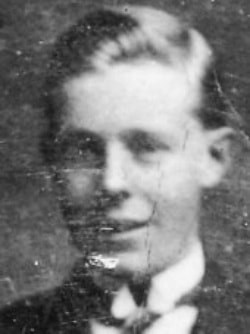
33003 Private
John Richard Suthon
10th Bn. King's Shropshire Light Infantry
30th November 1917
Plot E. 52.
Picture courtesy of Dave Shaw
John Richard Suthon
10th Bn. King's Shropshire Light Infantry
30th November 1917
Plot E. 52.
Picture courtesy of Dave Shaw

3290 Trooper
Victor Turnball
7th Australian Light Horse
7th May 1918, aged 19.
Plot H. 30.
Son of Joseph Pearson Turnbull and Edith Turnbull, of Thornton St., Wellington, New South Wales. Native of Gallymont, New South Wales.
His headstone bears the inscription "Called To Higher Service"
Studio portrait of 3290 Trooper Victor 'Vic' Turnbull, was the son of Joseph Pearson Turnbull and Edith Turnbull of Thornton Street, Wellington, NSW, and was a native of the Gallymont area of the District. He attended State Public School and later worked in the grocery trade before enlisting at Wellington on 28 February 1917. Turnbull later became a member of B Squadron, 7th Light Horse Regiment, which participated in operations in Palestine. In May 1918, Turnbull's Regiment was operating in the Es Salt area of Palestine when Turnbull was killed in unusual circumstances as later related by Trooper Hilton Hubbard of C Squadron of the Regiment. Hubbard said that, "the Regiment was in bivvy (bivouac) when a bomb descended, dropping in the midst of B Squadron tents, Vic and six others were killed". Trooper Turnbull was officially listed as killed in action on 7 May 1918 although there was some suggestion that the actual date of Turnbull's death could have been 7 April 1918. At the time of his death Trooper Victor Turnbull was 19 years of age and is buried in the Jerusalem War Cemetery.
Victor Turnball
7th Australian Light Horse
7th May 1918, aged 19.
Plot H. 30.
Son of Joseph Pearson Turnbull and Edith Turnbull, of Thornton St., Wellington, New South Wales. Native of Gallymont, New South Wales.
His headstone bears the inscription "Called To Higher Service"
Studio portrait of 3290 Trooper Victor 'Vic' Turnbull, was the son of Joseph Pearson Turnbull and Edith Turnbull of Thornton Street, Wellington, NSW, and was a native of the Gallymont area of the District. He attended State Public School and later worked in the grocery trade before enlisting at Wellington on 28 February 1917. Turnbull later became a member of B Squadron, 7th Light Horse Regiment, which participated in operations in Palestine. In May 1918, Turnbull's Regiment was operating in the Es Salt area of Palestine when Turnbull was killed in unusual circumstances as later related by Trooper Hilton Hubbard of C Squadron of the Regiment. Hubbard said that, "the Regiment was in bivvy (bivouac) when a bomb descended, dropping in the midst of B Squadron tents, Vic and six others were killed". Trooper Turnbull was officially listed as killed in action on 7 May 1918 although there was some suggestion that the actual date of Turnbull's death could have been 7 April 1918. At the time of his death Trooper Victor Turnbull was 19 years of age and is buried in the Jerusalem War Cemetery.

